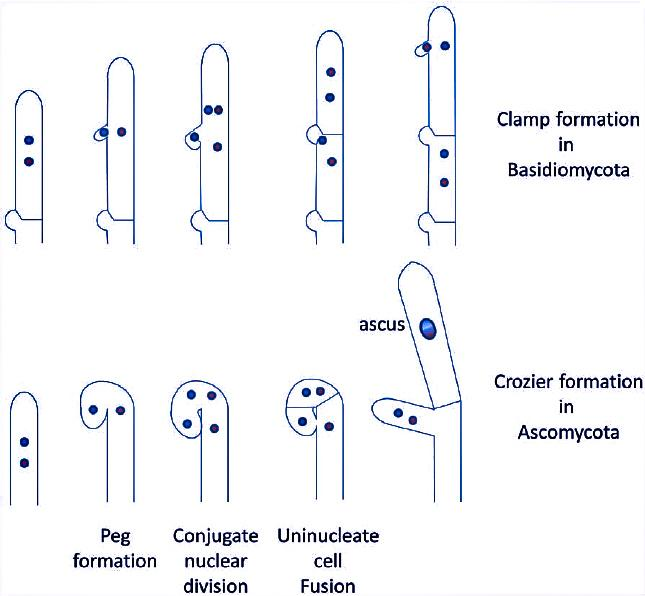
Dikaryon formation occurs in
(a)Phycomycetes and slime molds
(b)Ascomycetes and slime molds
(c)Ascomycetes and Basidiomycetes
(d)Phycomycetes and Basidiomycetes
Answer
509.1k+ views
Hint: They belong to the subkingdom Dikarya that is the group of higher fungi and is the largest phylum and divisions of the kingdom fungi.
Complete answer:
The dikaryon is a feature of the nucleus which is found in fungi unique to various species. It is a primitive character in the subkingdom Dikarya, which includes both the Ascomycetes and Basidiomycetes. The croziers of ascomycetes and the clamp collection of basidiomycetes are responsible for the maintenance of dikaryon.
Additional Information:
-Dikaryons are present in many fungi except the green algae Derbesia.
-The exception of green algae was challenged after the heterokaryotic hypothesis (multinucleated cells with different nuclei).
-In ascomycetes crozier (structure formed at the base of asci) is required to form dikaryons.
-In basidiomycetes clamp collection (hook-like structure formed by hyphal cells) is required to form dikaryons.
-Ascomycetes are also known as sac fungi. It is the largest phylum of fungi.
-It's characteristic feature is the formation of non-motile spores called ascospores.
-Basidiomycetes are also known as the club fungi, due to the production of the spores that are club-shaped.
-Basidiomycetes are the filamentous fungi with hyphae and form club-shaped cells called basidia for sexual reproduction.
-The basidia contain specialized spores called basidiospores.

So, the correct answer is ‘Ascomycetes and Basidiomycetes’.
Note: The term dikaryon is derived from the Greek word di meaning ‘two’ and karyon meaning ‘nut’. It is in the context of the cell nucleus. The phylum fungi were discovered by an American biologist R. H. Whittaker. He stated that the fungi are different from other eukaryotes in several aspects. So, in his five-kingdom classification, Whittaker added a separate phylum for fungi.
Complete answer:
The dikaryon is a feature of the nucleus which is found in fungi unique to various species. It is a primitive character in the subkingdom Dikarya, which includes both the Ascomycetes and Basidiomycetes. The croziers of ascomycetes and the clamp collection of basidiomycetes are responsible for the maintenance of dikaryon.
Additional Information:
-Dikaryons are present in many fungi except the green algae Derbesia.
-The exception of green algae was challenged after the heterokaryotic hypothesis (multinucleated cells with different nuclei).
-In ascomycetes crozier (structure formed at the base of asci) is required to form dikaryons.
-In basidiomycetes clamp collection (hook-like structure formed by hyphal cells) is required to form dikaryons.
-Ascomycetes are also known as sac fungi. It is the largest phylum of fungi.
-It's characteristic feature is the formation of non-motile spores called ascospores.
-Basidiomycetes are also known as the club fungi, due to the production of the spores that are club-shaped.
-Basidiomycetes are the filamentous fungi with hyphae and form club-shaped cells called basidia for sexual reproduction.
-The basidia contain specialized spores called basidiospores.

So, the correct answer is ‘Ascomycetes and Basidiomycetes’.
Note: The term dikaryon is derived from the Greek word di meaning ‘two’ and karyon meaning ‘nut’. It is in the context of the cell nucleus. The phylum fungi were discovered by an American biologist R. H. Whittaker. He stated that the fungi are different from other eukaryotes in several aspects. So, in his five-kingdom classification, Whittaker added a separate phylum for fungi.
Recently Updated Pages
Master Class 11 Business Studies: Engaging Questions & Answers for Success

Master Class 11 Accountancy: Engaging Questions & Answers for Success

Master Class 11 Computer Science: Engaging Questions & Answers for Success

Master Class 11 English: Engaging Questions & Answers for Success

Master Class 11 Social Science: Engaging Questions & Answers for Success

Master Class 11 Economics: Engaging Questions & Answers for Success

Trending doubts
Which one is a true fish A Jellyfish B Starfish C Dogfish class 11 biology CBSE

State and prove Bernoullis theorem class 11 physics CBSE

1 ton equals to A 100 kg B 1000 kg C 10 kg D 10000 class 11 physics CBSE

In which part of the body the blood is purified oxygenation class 11 biology CBSE

One Metric ton is equal to kg A 10000 B 1000 C 100 class 11 physics CBSE

Difference Between Prokaryotic Cells and Eukaryotic Cells




